Trung Hieu Nguyen
Emotional Dimension Control in Language Model-Based Text-to-Speech: Spanning a Broad Spectrum of Human Emotions
Sep 25, 2024Abstract:Current emotional text-to-speech (TTS) systems face challenges in mimicking a broad spectrum of human emotions due to the inherent complexity of emotions and limitations in emotional speech datasets and models. This paper proposes a TTS framework that facilitates control over pleasure, arousal, and dominance, and can synthesize a diversity of emotional styles without requiring any emotional speech data during TTS training. We train an emotional attribute predictor using only categorical labels from speech data, aligning with psychological research and incorporating anchored dimensionality reduction on self-supervised learning (SSL) features. The TTS framework converts text inputs into phonetic tokens via an autoregressive language model and uses pseudo-emotional dimensions to guide the parallel prediction of fine-grained acoustic details. Experiments conducted on the LibriTTS dataset demonstrate that our framework can synthesize speech with enhanced naturalness and a variety of emotional styles by effectively controlling emotional dimensions, even without the inclusion of any emotional speech during TTS training.
MossFormer2: Combining Transformer and RNN-Free Recurrent Network for Enhanced Time-Domain Monaural Speech Separation
Dec 19, 2023



Abstract:Our previously proposed MossFormer has achieved promising performance in monaural speech separation. However, it predominantly adopts a self-attention-based MossFormer module, which tends to emphasize longer-range, coarser-scale dependencies, with a deficiency in effectively modelling finer-scale recurrent patterns. In this paper, we introduce a novel hybrid model that provides the capabilities to model both long-range, coarse-scale dependencies and fine-scale recurrent patterns by integrating a recurrent module into the MossFormer framework. Instead of applying the recurrent neural networks (RNNs) that use traditional recurrent connections, we present a recurrent module based on a feedforward sequential memory network (FSMN), which is considered "RNN-free" recurrent network due to the ability to capture recurrent patterns without using recurrent connections. Our recurrent module mainly comprises an enhanced dilated FSMN block by using gated convolutional units (GCU) and dense connections. In addition, a bottleneck layer and an output layer are also added for controlling information flow. The recurrent module relies on linear projections and convolutions for seamless, parallel processing of the entire sequence. The integrated MossFormer2 hybrid model demonstrates remarkable enhancements over MossFormer and surpasses other state-of-the-art methods in WSJ0-2/3mix, Libri2Mix, and WHAM!/WHAMR! benchmarks.
SPGM: Prioritizing Local Features for enhanced speech separation performance
Sep 22, 2023



Abstract:Dual-path is a popular architecture for speech separation models (e.g. Sepformer) which splits long sequences into overlapping chunks for its intra- and inter-blocks that separately model intra-chunk local features and inter-chunk global relationships. However, it has been found that inter-blocks, which comprise half a dual-path model's parameters, contribute minimally to performance. Thus, we propose the Single-Path Global Modulation (SPGM) block to replace inter-blocks. SPGM is named after its structure consisting of a parameter-free global pooling module followed by a modulation module comprising only 2% of the model's total parameters. The SPGM block allows all transformer layers in the model to be dedicated to local feature modelling, making the overall model single-path. SPGM achieves 22.1 dB SI-SDRi on WSJ0-2Mix and 20.4 dB SI-SDRi on Libri2Mix, exceeding the performance of Sepformer by 0.5 dB and 0.3 dB respectively and matches the performance of recent SOTA models with up to 8 times fewer parameters.
Are Soft Prompts Good Zero-shot Learners for Speech Recognition?
Sep 18, 2023



Abstract:Large self-supervised pre-trained speech models require computationally expensive fine-tuning for downstream tasks. Soft prompt tuning offers a simple parameter-efficient alternative by utilizing minimal soft prompt guidance, enhancing portability while also maintaining competitive performance. However, not many people understand how and why this is so. In this study, we aim to deepen our understanding of this emerging method by investigating the role of soft prompts in automatic speech recognition (ASR). Our findings highlight their role as zero-shot learners in improving ASR performance but also make them vulnerable to malicious modifications. Soft prompts aid generalization but are not obligatory for inference. We also identify two primary roles of soft prompts: content refinement and noise information enhancement, which enhances robustness against background noise. Additionally, we propose an effective modification on noise prompts to show that they are capable of zero-shot learning on adapting to out-of-distribution noise environments.
ACA-Net: Towards Lightweight Speaker Verification using Asymmetric Cross Attention
May 20, 2023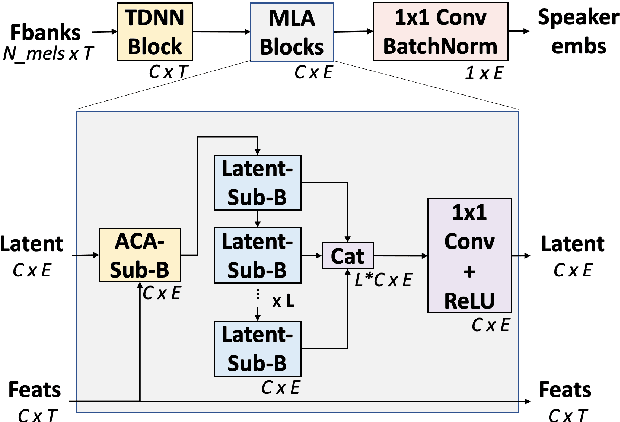
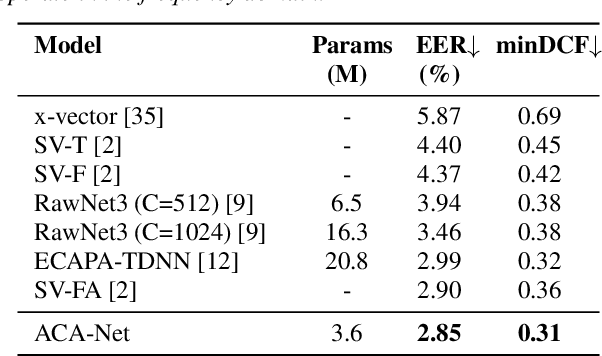
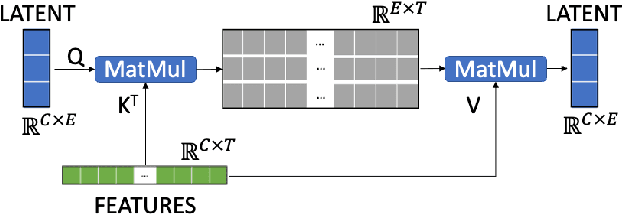
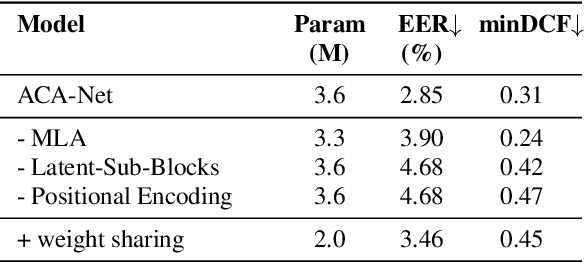
Abstract:In this paper, we propose ACA-Net, a lightweight, global context-aware speaker embedding extractor for Speaker Verification (SV) that improves upon existing work by using Asymmetric Cross Attention (ACA) to replace temporal pooling. ACA is able to distill large, variable-length sequences into small, fixed-sized latents by attending a small query to large key and value matrices. In ACA-Net, we build a Multi-Layer Aggregation (MLA) block using ACA to generate fixed-sized identity vectors from variable-length inputs. Through global attention, ACA-Net acts as an efficient global feature extractor that adapts to temporal variability unlike existing SV models that apply a fixed function for pooling over the temporal dimension which may obscure information about the signal's non-stationary temporal variability. Our experiments on the WSJ0-1talker show ACA-Net outperforms a strong baseline by 5\% relative improvement in EER using only 1/5 of the parameters.
Contrastive Speech Mixup for Low-resource Keyword Spotting
May 02, 2023Abstract:Most of the existing neural-based models for keyword spotting (KWS) in smart devices require thousands of training samples to learn a decent audio representation. However, with the rising demand for smart devices to become more personalized, KWS models need to adapt quickly to smaller user samples. To tackle this challenge, we propose a contrastive speech mixup (CosMix) learning algorithm for low-resource KWS. CosMix introduces an auxiliary contrastive loss to the existing mixup augmentation technique to maximize the relative similarity between the original pre-mixed samples and the augmented samples. The goal is to inject enhancing constraints to guide the model towards simpler but richer content-based speech representations from two augmented views (i.e. noisy mixed and clean pre-mixed utterances). We conduct our experiments on the Google Speech Command dataset, where we trim the size of the training set to as small as 2.5 mins per keyword to simulate a low-resource condition. Our experimental results show a consistent improvement in the performance of multiple models, which exhibits the effectiveness of our method.
Adaptive Knowledge Distillation between Text and Speech Pre-trained Models
Mar 07, 2023Abstract:Learning on a massive amount of speech corpus leads to the recent success of many self-supervised speech models. With knowledge distillation, these models may also benefit from the knowledge encoded by language models that are pre-trained on rich sources of texts. The distillation process, however, is challenging due to the modal disparity between textual and speech embedding spaces. This paper studies metric-based distillation to align the embedding space of text and speech with only a small amount of data without modifying the model structure. Since the semantic and granularity gap between text and speech has been omitted in literature, which impairs the distillation, we propose the Prior-informed Adaptive knowledge Distillation (PAD) that adaptively leverages text/speech units of variable granularity and prior distributions to achieve better global and local alignments between text and speech pre-trained models. We evaluate on three spoken language understanding benchmarks to show that PAD is more effective in transferring linguistic knowledge than other metric-based distillation approaches.
Monaural Speech Enhancement with Complex Convolutional Block Attention Module and Joint Time Frequency Losses
Feb 03, 2021
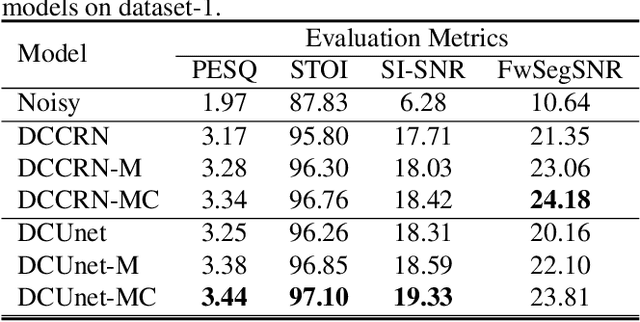
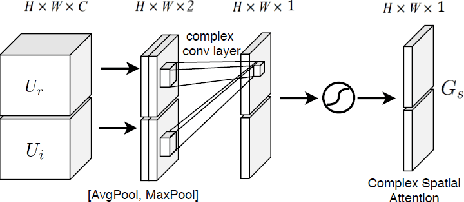
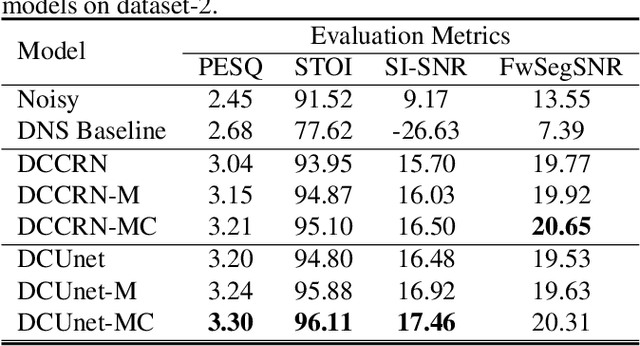
Abstract:Deep complex U-Net structure and convolutional recurrent network (CRN) structure achieve state-of-the-art performance for monaural speech enhancement. Both deep complex U-Net and CRN are encoder and decoder structures with skip connections, which heavily rely on the representation power of the complex-valued convolutional layers. In this paper, we propose a complex convolutional block attention module (CCBAM) to boost the representation power of the complex-valued convolutional layers by constructing more informative features. The CCBAM is a lightweight and general module which can be easily integrated into any complex-valued convolutional layers. We integrate CCBAM with the deep complex U-Net and CRN to enhance their performance for speech enhancement. We further propose a mixed loss function to jointly optimize the complex models in both time-frequency (TF) domain and time domain. By integrating CCBAM and the mixed loss, we form a new end-to-end (E2E) complex speech enhancement framework. Ablation experiments and objective evaluations show the superior performance of the proposed approaches.
Towards Natural and Controllable Cross-Lingual Voice Conversion Based on Neural TTS Model and Phonetic Posteriorgram
Feb 03, 2021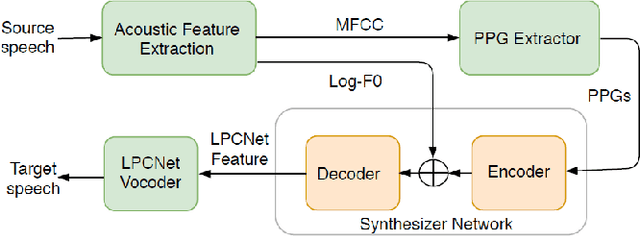

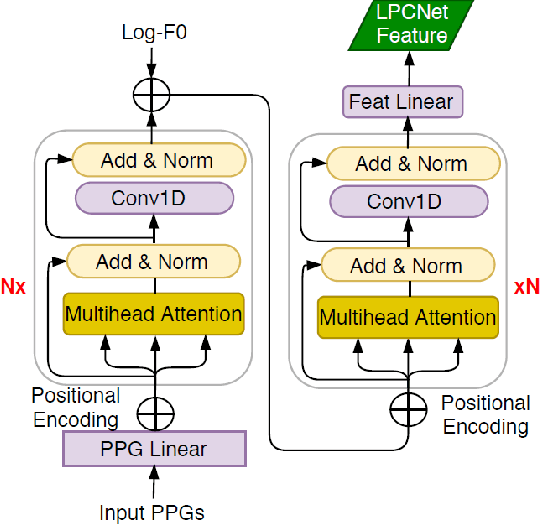

Abstract:Cross-lingual voice conversion (VC) is an important and challenging problem due to significant mismatches of the phonetic set and the speech prosody of different languages. In this paper, we build upon the neural text-to-speech (TTS) model, i.e., FastSpeech, and LPCNet neural vocoder to design a new cross-lingual VC framework named FastSpeech-VC. We address the mismatches of the phonetic set and the speech prosody by applying Phonetic PosteriorGrams (PPGs), which have been proved to bridge across speaker and language boundaries. Moreover, we add normalized logarithm-scale fundamental frequency (Log-F0) to further compensate for the prosodic mismatches and significantly improve naturalness. Our experiments on English and Mandarin languages demonstrate that with only mono-lingual corpus, the proposed FastSpeech-VC can achieve high quality converted speech with mean opinion score (MOS) close to the professional records while maintaining good speaker similarity. Compared to the baselines using Tacotron2 and Transformer TTS models, the FastSpeech-VC can achieve controllable converted speech rate and much faster inference speed. More importantly, the FastSpeech-VC can easily be adapted to a speaker with limited training utterances.
Towards Natural Bilingual and Code-Switched Speech Synthesis Based on Mix of Monolingual Recordings and Cross-Lingual Voice Conversion
Oct 16, 2020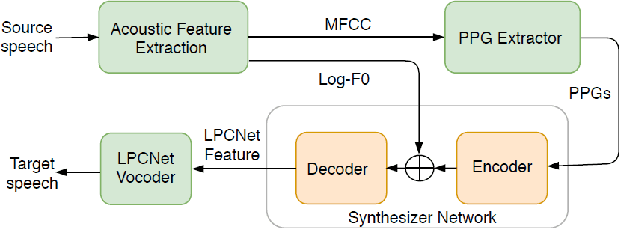

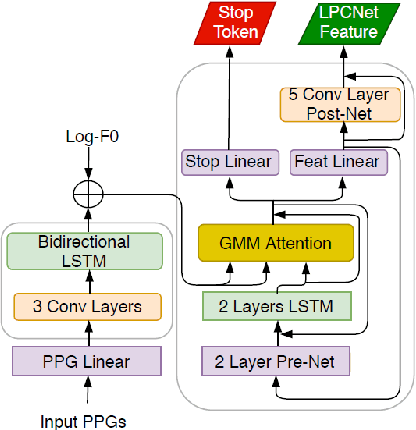

Abstract:Recent state-of-the-art neural text-to-speech (TTS) synthesis models have dramatically improved intelligibility and naturalness of generated speech from text. However, building a good bilingual or code-switched TTS for a particular voice is still a challenge. The main reason is that it is not easy to obtain a bilingual corpus from a speaker who achieves native-level fluency in both languages. In this paper, we explore the use of Mandarin speech recordings from a Mandarin speaker, and English speech recordings from another English speaker to build high-quality bilingual and code-switched TTS for both speakers. A Tacotron2-based cross-lingual voice conversion system is employed to generate the Mandarin speaker's English speech and the English speaker's Mandarin speech, which show good naturalness and speaker similarity. The obtained bilingual data are then augmented with code-switched utterances synthesized using a Transformer model. With these data, three neural TTS models -- Tacotron2, Transformer and FastSpeech are applied for building bilingual and code-switched TTS. Subjective evaluation results show that all the three systems can produce (near-)native-level speech in both languages for each of the speaker.
 Add to Chrome
Add to Chrome Add to Firefox
Add to Firefox Add to Edge
Add to Edge